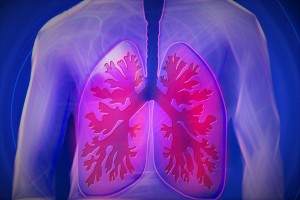Pulmonary embolism happens when one of the pulmonary arteries in your lungs becomes blocked. It is usually caused when a blood clot breaks off from a vein in the legs (deep vein thrombosis or DVT) and travels to the lungs, although it can also travel from a clot in the veins of the arms. Sometimes the origin of the clot is not found.1 Pulmonary embolism is a little-talked-about, dramatic killer which is often missed in hospitals. There is a study which reveals that up to 40% of patients admitted to the hospital with a COPD exacerbation (emphysema) actually have a pulmonary embolism.2,3 There are even young people presenting in the emergency room with signs of pulmonary embolism who are usually thought to be simply dehydrated, but actually have a pulmonary embolism. With the advent of video gaming which keeps one sitting still without much movement for a very long time (now apparently classified as an addiction),4 the incidence of pulmonary embolism in young people has risen dramatically. Hormone replacement therapy, birth control pills, patches, and vaginal devices, can also increase the risk of pulmonary embolism.
Pulmonary Embolism Symptoms
(Please also bear in mind, there may even be NO symptoms when pulmonary embolism is present)
- Shortness of breath or difficulty breathing
- Chest pain
- Coughing, or coughing up blood
- Swelling/tenderness in one leg, or along the leg vein, increased warmth or redness on the leg
- Sometimes symptoms include anxiousness, sweating, rapid breathing, quickened heart rate, lightheadedness, or fainting5
Causes of Pulmonary Embolism
Sitting for Prolonged Periods of Time
Sitting for too long can cause pulmonary embolism. Many of us remember in 2003 (and were shocked to hear) that the NBC News correspondent, David Bloom (in the prime of his life), “died from a blot clot” (pulmonary embolism) “while traveling with troops about 25 miles south of Baghdad when he suddenly collapsed.”6 He had been sitting and crouched in a Humvee (military light truck) for extended periods of time without moving his legs.
Air Travel
Plane flights (especially extremely long flights) are hazardous where pulmonary embolism is concerned – especially when squished in economy class. When on a plane, people need to move their legs, pump their legs, get up if they can when it is safe from a turbulence standpoint, and hydrate as much as possible. Dehydration contributes to blood clot formation.7 Alcohol should be avoided while flying as it is very dehydrating to the body. Coffee should actually be avoided as well when flying because it is a diuretic.
Long Car Trips and Coach Tours
Taking long car trips without stopping regularly to stretch and walk around can cause pulmonary embolism. Coach tours (e.g., people going on a “package tour” to see large swathes of Europe, etc.) are very dangerous where pulmonary embolism is concerned. The goal of these tours is to cover as much ground as possible in a set amount of time, which usually means having people sit for hours on end in between tourist stops.
Video Gaming
Video gaming is highly addictive, and dangerous. People sit for hours on end (without realizing it), and even DAYS without moving their legs! Sadly, it is not unusual to read headlines like: “Man Dies From Blood Clot After Marathon Gaming.”8 And bear in mind, this was a young man of 20 years old. Sadly, video gaming addiction is affecting children, too; “Ohio teen hospitalized after playing video games for at least 4 straight days.”9 One article has even coined it “Gamer’s Thrombosis”– which hopefully brings home the point that playing video games can actually be deadly!10 Parents need to be VERY aware of this situation and limit the amount of time their children play video games.
Any Long Period of Inactivity for Any Reason
Being inactive for any reason: after a major surgery (especially joint replacement), an illness, or being bed-ridden for any reason whatsoever means that you’re not moving your legs to promote blood flow. If you must be inactive for extended periods for any reason, move your legs, pump your calves by stretching your toes up toward your face and back down repeatedly so that your calf muscles are engaged. This simple exercise will help keep your blood flowing during times of inactivity, and it can be easily done in bed.
Hormone Replacement Therapy, Birth Control Pills, Patches, and Vaginal Devices
Hormone replacement therapy, especially oral synthetic hormone replacement poses increased risk for pulmonary embolism. “The risk of a thrombotic event is greater within the first two years of starting treatment.”11 Also, please understand, if you are obese, AND use hormone replacement therapy, your risk for pulmonary embolism increases yet again.
Birth Control Pills: It must first be stated that obese women using hormonal contraception are automatically at a higher risk for pulmonary embolism.12 In the case of birth control pills, combination pills which contain the hormone, “drospireneone,” have been linked to increased risk of pulmonary embolism.13
Birth control patches are no exception. One study even found that risk of pulmonary embolism for women using patches actually increased two-fold.14
Vaginal contraception devices, particularly those containing etonogestrel/ethinyl estradiol, have been proven to have at least as much potential for thromboembolic events as combined oral contraceptives.15,16 In some cases, they may even be more of a problem than other forms of birth control where pulmonary embolism is concerned.17
Being Overweight
Obese people are actually more prone to pulmonary embolism. Being overweight increases your risk of pulmonary embolism in that it leads to stagnation of blood in the veins.18 Obesity ups the risk of pulmonary embolism in both men and women, but even more so for women.19
Certain Types of Cancer, Heart Disease, and Being Over Age 60
Where cancer is concerned: mainly with pancreatic, lung, multiple myeloma, and hematologic cancers, “There is a balance in the body between pro-clotting and anti-clotting activity, … Cancer skews the balance in terms of pro-clotting, increases inflammation, and compresses blood vessels, all risk factors for developing clots.” say Jean Connors, MD, Women’s Hospital and Dana-Farber Cancer Institute.20
People with heart disease are at greater risk for pulmonary embolism because they are usually more sedentary, and also may have genetic clotting problems to being with. There is also more risk of pulmonary embolism not connected with peripheral vein thrombosis for people with heart disease.21
Statistically speaking, simply being over the age of 60 increases the risk for pulmonary embolism – in most cases simply because of being less active, and other factors (listed above) are more likely to be present in many people after age 60.
Smoking
Smoking has an adverse affect on blood circulation and blood clotting. It is well known that smoking is an enormous risk factor for cancer and cardiovascular disease. When smoking, obesity, and hypertension (high blood pressure) are present all at once (which is often the case), it is the perfect storm for a pulmonary embolism.22
Reducing the Risk of Pulmonary Embolism
- Take off excess weight
- Don’t sit for any longer than half-an-hour without getting up and moving. Limit your children’s time (and your time) with video games.
- Exercise regularly. This doesn’t mean to overdo it at the gym every day. If you like to go to the gym, that’s great. But “regular exercise” can be simply walking for 20-30 minutes each day – even several times a day, if possible. It can also mean doing housework or other physical activity. Getting moving gets your heart rate up, and your blood flowing!
- Stop smoking
- Discuss the pros and cons of different types of contraception and hormone replacement therapy at length with your doctor. Learn about the side-effects of each method/type online. If you have questions you don’t feel your doctor has addressed sufficiently, seek another opinion.
After a Blood Clot Diagnosis
Immediately see a hematologist to be sure there is not a genetic predisposition to blood clots. Close monitoring is necessary to make sure the therapy given is working properly. People who do have a genetic predisposition must be monitored carefully because they can often clot at the lower therapeutic levels of blood thinners and generally need to be anti-coagulated throughout their lifetime.
Also, obese people need more careful monitoring as in some cases they can develop blood clots on the newer blood thinning medications which do not require monitoring the level of blood thinning.


